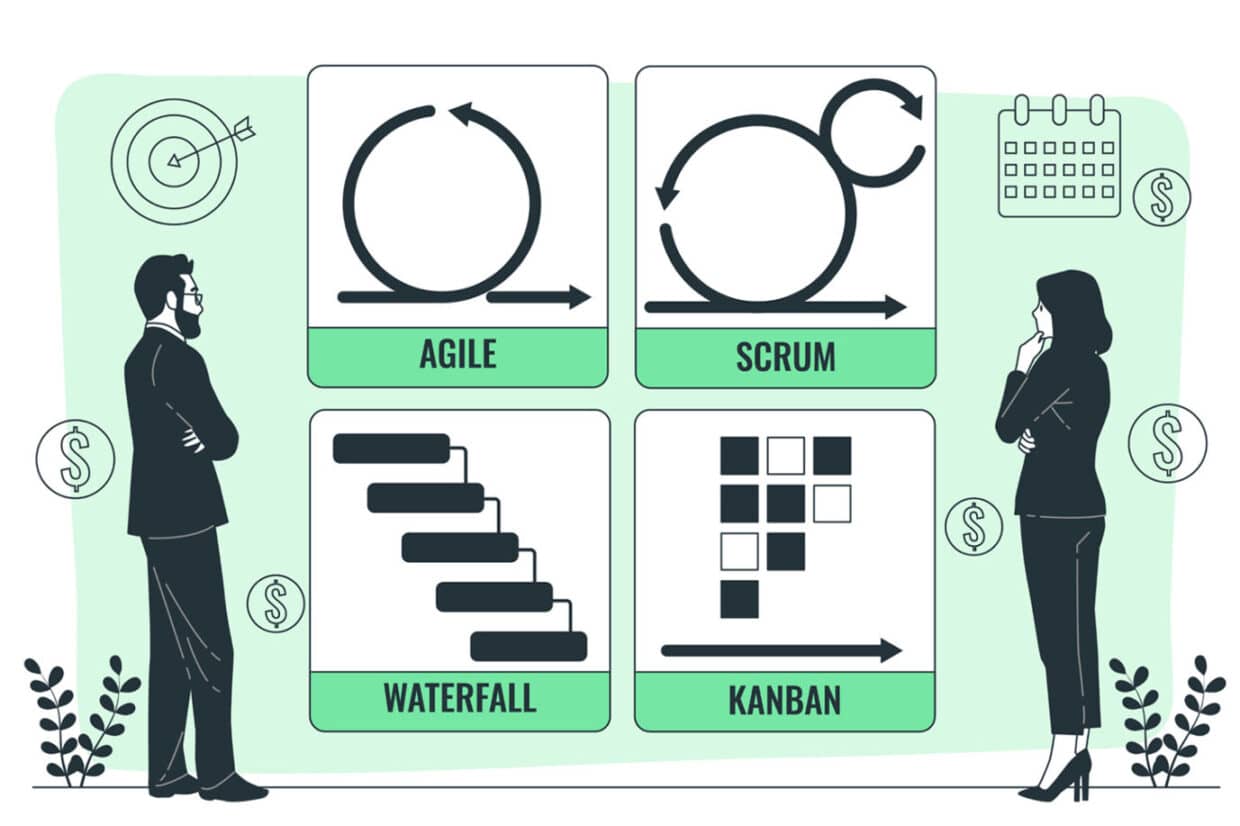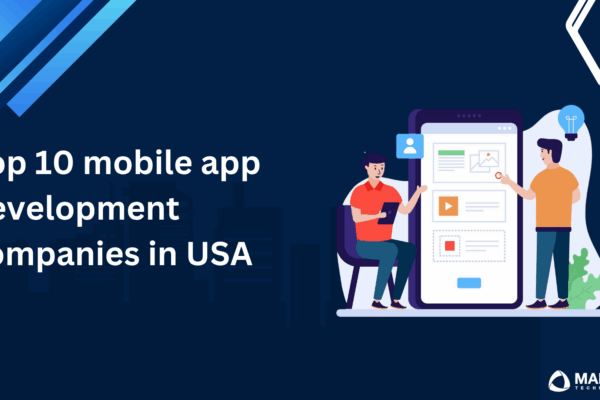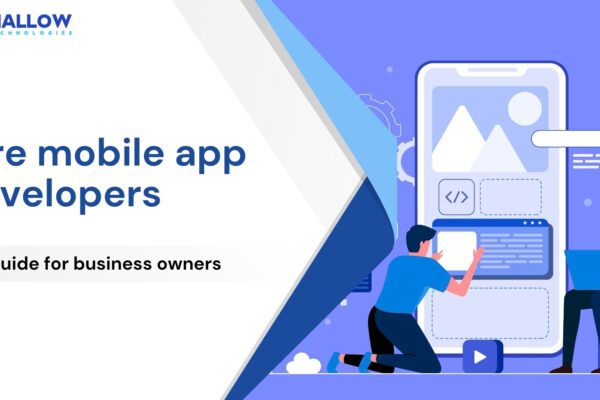When it comes to application development, having the right project management methodology is crucial for success. Without a suitable approach in place, applications may encounter difficulty in tracking and managing project progress, as there may be no clear structure or framework in place to monitor tasks, timelines, and milestones.
We at Mallow have successfully managed numerous projects across various industries, gaining insights into the intricacies and challenges of different methodologies. Over a span of more than 12 years, our expertise stems from our ability to analyse complex project scenarios, identify pain points, and recommend the most suitable methodology for each unique situation tailored exclusively for your application.
This blog provides valuable insights and guidance on the distinctive characteristics, benefits, and drawbacks of both methodologies. By exploring the key considerations involved in the decision-making process, such as project requirements, and team dynamics, readers will gain a comprehensive understanding of how to navigate this dilemma effectively.
Understanding the Waterfall methodology
Waterfall methodology is a traditional, linear project management approach that follows a sequential and structured process. It is characterised by a predetermined set of phases and a top-down, one-directional flow.
In the waterfall model, each phase must be completed before moving on to the next, and there is minimal room for changes or iterations once a phase is completed. Key features of the waterfall methodology include its emphasis on upfront planning, clear documentation, and well-defined project scope.
Waterfall methodology is well-suited for projects with stable and well-understood requirements, where changes are unlikely or minimal. It is often applied in industries such as construction, manufacturing, and regulated environments, where a comprehensive plan and strict adherence to specifications are crucial. The waterfall can be effective when working with clients who have a clear vision and well-defined expectations from the outset and where a high level of predictability and control is desired.
What are the typical phases of the waterfall approach?
The waterfall methodology follows a fixed sequence of phases, where each phase builds upon the completion of the previous one. The typical phases in the waterfall are as follows:
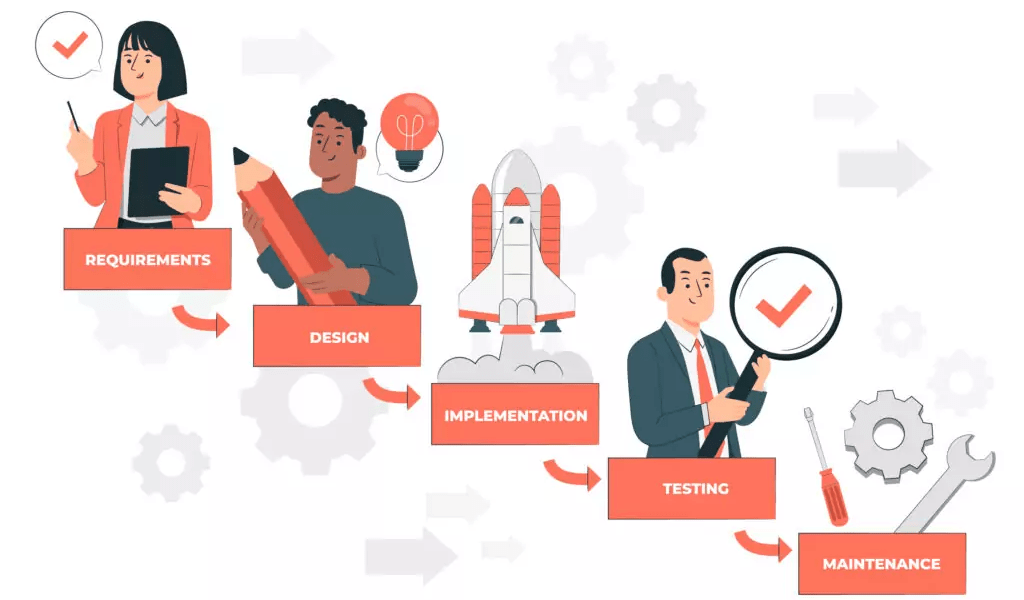
1. Requirements gathering
In this initial phase, project requirements are gathered, analysed, and documented in detail. This phase sets the foundation for the entire project.
2. System design
The system design phase focuses on creating a comprehensive technical design that outlines how the application will be structured, including architecture, database design, and other technical specifications.
3. Implementation
This phase involves the actual coding and development of the application based on the requirements and design specifications. The development process follows a linear progression.
4. Testing
Once the implementation phase is complete, testing is conducted to verify that the application functions as intended and meets the specified requirements. Testing includes unit testing, integration testing, and system testing.
5. Deployment
After successful testing, the application is deployed to the production environment, making it accessible to end-users.
6. Maintenance
The maintenance phase involves ongoing support, bug fixes, and updates throughout the application’s lifecycle to ensure its smooth operation.
What are some of the drawbacks of the waterfall approach?
1.
The rigid nature of the waterfall makes it challenging to accommodate changes or revisions once a phase is completed, leading to potential delays and increased costs if modifications are required later.
2.
Waterfall does not allow for iterative development or feedback loops, which can restrict the ability to incorporate continuous improvement and adapt to evolving project needs.
3.
Since testing and user feedback occur towards the end of the development process, there is a higher risk of discovering issues late in the project lifecycle, potentially resulting in costly rework.
Understanding the Agile methodology
Agile methodology is an iterative and collaborative approach to project management that prioritises flexibility, adaptability, and continuous improvement. It is designed to address the limitations of traditional, sequential methods by promoting incremental development, frequent feedback loops, and close collaboration between cross-functional teams.
Key features of Agile include its focus on delivering value in short iterations, embracing change throughout the project lifecycle, and fostering a highly collaborative and self-organising team environment.
Agile methodology is particularly suitable for projects with evolving requirements, complex problem domains, or those operating in rapidly changing markets. It is well-suited for software development projects, where regular iterations allow for incremental improvements and quick responses to user feedback.
Agile is highly effective for projects that require innovation, collaboration, and a high level of stakeholder involvement. It is often employed in startups, creative industries, and organisations that value adaptability, customer-centricity, and continuous delivery.
What does the agile approach look like?
The agile methodology follows an iterative and incremental development approach. Instead of attempting to define and deliver the entire project upfront, Agile breaks it down into smaller, manageable units called iterations or sprints.
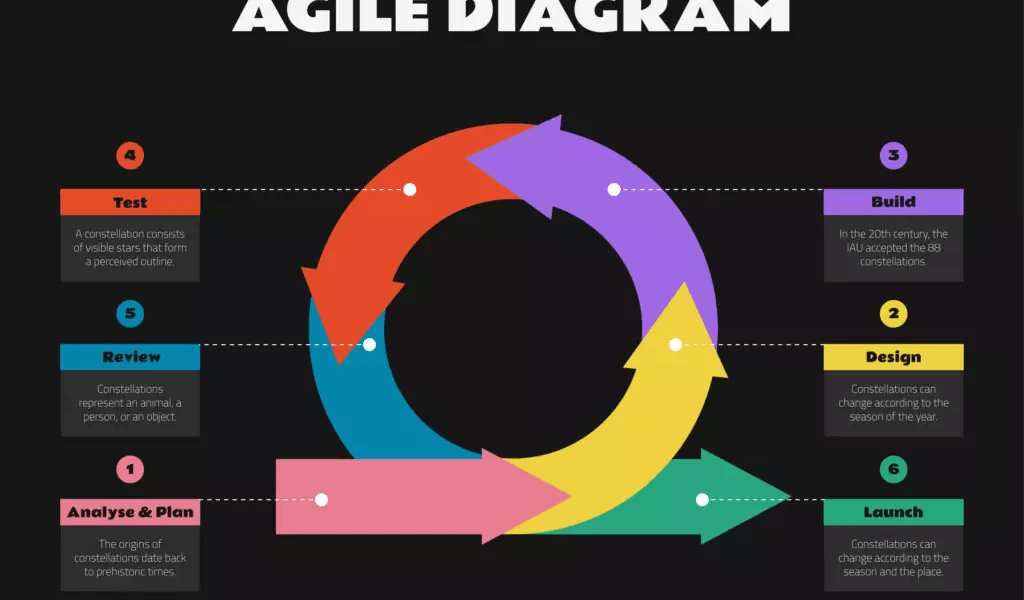
Each iteration typically lasts a few weeks and involves a series of activities, including planning, development, testing, and review.
The team delivers a functional increment of the application at the end of each iteration, incorporating feedback and making adjustments based on stakeholder input. This iterative process allows for early and frequent delivery of value, promotes continuous learning, and enables adaptation to changing requirements.
What are some of the drawbacks of the agile approach?
1. Initial Learning Curve
Agile requires a mindset shift and a change in traditional project management practices. Teams and stakeholders may need time to adapt to the new way of working and the collaborative decision-making processes.
2. Increased Stakeholder Involvement
Agile methodology requires active engagement and involvement from stakeholders throughout the project. This may demand additional time and commitment from stakeholders, which can be challenging in certain environments.
3. Potential Scope Creep
Without clear boundaries and effective scope management, Agile projects can be prone to scope creep if changes and additions are not carefully managed.
Are there hybrid approaches or alternative methodologies?
1. Blending agile and waterfall elements
Hybrid approaches involve blending elements from both Agile and Waterfall methodologies to create a customised framework that suits the specific project requirements.For example, you can incorporate Agile principles like iterative development and continuous feedback while maintaining a more structured and sequential approach for certain phases or deliverables. This flexibility allows for a tailored approach that leverages the strengths of both methodologies.
2. Kanban and lean methodologies
Kanban and Lean methodologies focus on optimising workflow efficiency, reducing waste, and visualising work processes.Kanban utilises a visual board to track tasks and limit work in progress, promoting a steady and controlled flow of work.Lean methodology emphasises continuous improvement and waste reduction through techniques such as value stream mapping and root cause analysis. These methodologies can be applied independently or integrated with other project management approaches to enhance productivity and streamline processes.
3. Scrum framework
Scrum is an Agile framework that enables teams to work collaboratively and iteratively. It emphasises small, cross-functional teams working in time-boxed iterations called sprints.The Scrum framework includes specific roles (such as Scrum Master and Product Owner) and ceremonies (such as daily stand-ups and sprint reviews) to facilitate communication, transparency, and adaptability. Scrum is particularly effective for complex projects where requirements may change, and frequent stakeholder involvement is crucial.
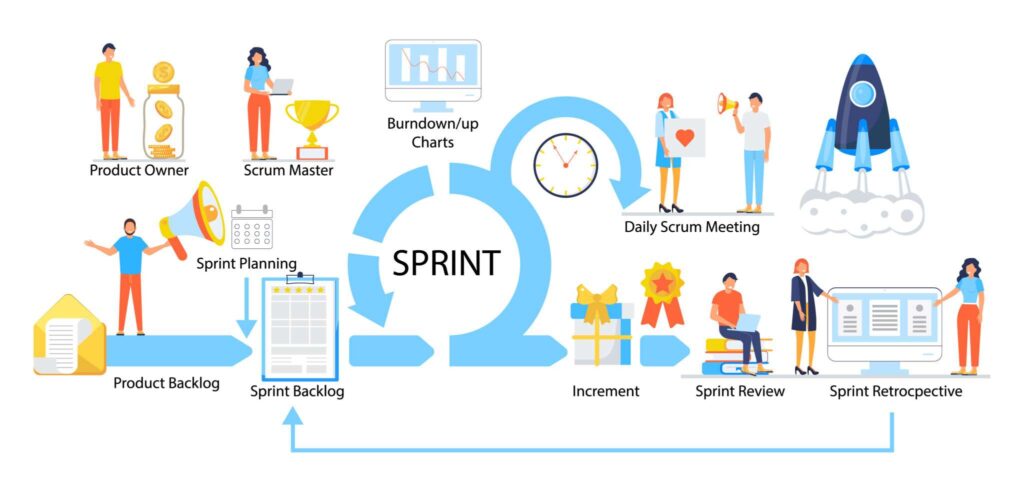
Scrum framework scheme illustration. Daily Srum meeting, retrospective, demo meeting with computer screen, clock, to do list are shown. Scrum master, owner. Development team working process concept.
How to choose the right project management methodology for my application?
Step 1: Assessing project characteristics
When deciding between Agile and Waterfall methodologies, it is essential to assess the project characteristics and requirements. Consider factors such as project size, complexity, and stability of requirements. Agile is suitable for projects with evolving requirements and a need for flexibility, while Waterfall is more appropriate for projects with stable and well-defined requirements.
Step 2: Evaluating the capabilities
Evaluate the capabilities and experience of your project team. Agile requires a high level of collaboration, self-organisation, and adaptability. If your team is experienced in Agile practices and possesses the necessary skills, it can be a good fit. On the other hand, Waterfall may be a better choice if your team is more comfortable with a structured and sequential approach.
Step 3: Balance time, cost, and quality constraints
Consider the time, cost, and quality constraints of your project. Agile’s iterative approach allows for early value delivery but may require more time for multiple iterations. Waterfall, with its linear nature, can provide a more predictable timeline and budget. Assess the trade-offs between speed, budget, and quality to determine which methodology aligns best with your project’s constraints and priorities.
It is important to note that a hybrid approach or customised methodology can also be considered, blending elements from both Agile and Waterfall to suit the specific project requirements. This allows flexibility in adapting to different project phases or incorporating Agile principles within a more structured framework.
How can I ensure that the application development team I choose is well-suited for my selected project management methodology?
In the fast-paced world of application development, an effective project management methodology is essential for success. By following industry best practices and leveraging proven project management methodologies, you can streamline your development process and maximise the efficiency and effectiveness of your team.
Hiring the right application development team is the next crucial step that you take towards the success of your software project. With the abundance of options available, it is essential to have a strategic approach to identify and select the team that aligns with your project’s goals and requirements.
When hiring an application development team, consider factors such as their expertise in relevant technologies, track record of successful projects, communication skills, and cultural fit. Conduct thorough evaluations, including technical assessments, portfolio reviews, and interviews, to assess their capabilities and ensure seamless collaboration.
Interested in knowing more about how to hire your development team? Check out our article on choosing the right application development team: a step-by-step guide.
Still, wondering where to start next? Feel free to reach out to our team.
Your queries, our answers
Agile is an iterative, flexible approach that adapts to changes and delivers in sprints. Waterfall is a linear, sequential model where each phase is completed before moving to the next. Agile is dynamic, while Waterfall is structured and predictable.
Agile is better suited for large, complex projects due to its adaptability and continuous feedback cycles. It accommodates changing requirements and ensures iterative progress. Waterfall works well for simpler, well-defined projects.
At Mallow, we assess your project requirements, timeline, and complexity to recommend the best methodology. Our expertise spans both Agile and Waterfall, ensuring the chosen approach aligns with your business goals.
Agile emphasizes frequent collaboration, daily stand-ups, and cross-functional teamwork. Waterfall follows a hierarchical approach, where teams work in silos and collaborate at defined stages.
Yes, a hybrid model can blend Agile and Waterfall, utilizing the flexibility of Agile for development and the structure of Waterfall for planning. This approach suits projects with diverse needs.
Once the project is completed and all agreed-upon payments are made, full ownership of the source code and intellectual property rights are transferred to you. This ensures that you retain complete control over the software and its future development.
Yes, our Agile expertise enables us to incorporate changes seamlessly without affecting the overall project quality. This flexibility helps us meet dynamic business needs effectively.
We adapt based on your project needs. While we excel in Agile for iterative and flexible projects, we also implement Waterfall or hybrid approaches for structured and well-defined requirements.
Agile involves clients throughout the project, providing regular updates and seeking feedback. Waterfall engages clients primarily during the requirement and delivery phases, with limited interaction in between.
Yes, we offer post-development support and maintenance to ensure your software performs optimally. Whether you follow Agile or Waterfall, we’re here to assist you at every stage.
Author
Kamalavel Rajendran
Kamal is the CEO of Mallow Technologies, a visionary leader with a mission to harness the potential of technology for tackling a variety of business challenges. He established the company with the objective of delivering tailored software solutions that address the wide array of issues encountered by businesses. He firmly believes that technology, empowers businesses to make informed decisions and promotes growth from every angle. In his leisure time, Kamal exhibits a remarkable passion for the game of tennis, immersing himself fully in the game. Furthermore, beyond the confines of the tennis court, his unwavering enthusiasm for innovation is apparent as he stays at the forefront of the latest developments in the realms of both business and technology. His dedication to merging the worlds of business and technology positions him as a dynamic presence in the industry, continually seeking inventive solutions to propel companies towards new horizons.

